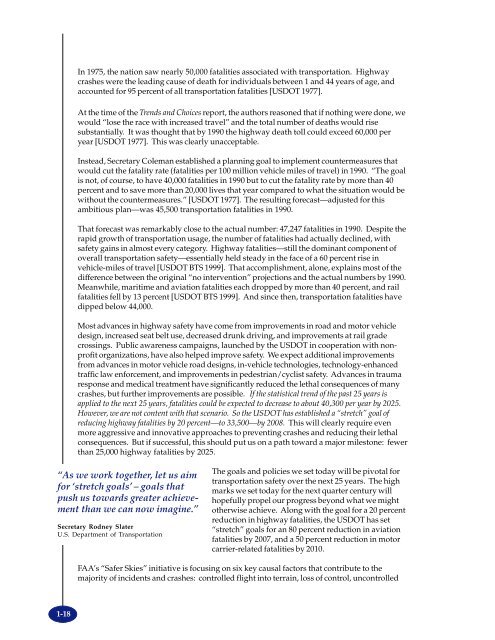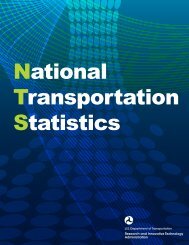TRANSPORTATION - BTS - Bureau of Transportation Statistics
TRANSPORTATION - BTS - Bureau of Transportation Statistics
TRANSPORTATION - BTS - Bureau of Transportation Statistics
You also want an ePaper? Increase the reach of your titles
YUMPU automatically turns print PDFs into web optimized ePapers that Google loves.
In 1975, the nation saw nearly 50,000 fatalities associated with transportation. Highwaycrashes were the leading cause <strong>of</strong> death for individuals between 1 and 44 years <strong>of</strong> age, andaccounted for 95 percent <strong>of</strong> all transportation fatalities [USDOT 1977].At the time <strong>of</strong> the Trends and Choices report, the authors reasoned that if nothing were done, wewould “lose the race with increased travel” and the total number <strong>of</strong> deaths would risesubstantially. It was thought that by 1990 the highway death toll could exceed 60,000 peryear [USDOT 1977]. This was clearly unacceptable.Instead, Secretary Coleman established a planning goal to implement countermeasures thatwould cut the fatality rate (fatalities per 100 million vehicle miles <strong>of</strong> travel) in 1990. “The goalis not, <strong>of</strong> course, to have 40,000 fatalities in 1990 but to cut the fatality rate by more than 40percent and to save more than 20,000 lives that year compared to what the situation would bewithout the countermeasures.” [USDOT 1977]. The resulting forecast—adjusted for thisambitious plan—was 45,500 transportation fatalities in 1990.That forecast was remarkably close to the actual number: 47,247 fatalities in 1990. Despite therapid growth <strong>of</strong> transportation usage, the number <strong>of</strong> fatalities had actually declined, withsafety gains in almost every category. Highway fatalities—still the dominant component <strong>of</strong>overall transportation safety—essentially held steady in the face <strong>of</strong> a 60 percent rise invehicle-miles <strong>of</strong> travel [USDOT <strong>BTS</strong> 1999]. That accomplishment, alone, explains most <strong>of</strong> thedifference between the original “no intervention” projections and the actual numbers by 1990.Meanwhile, maritime and aviation fatalities each dropped by more than 40 percent, and railfatalities fell by 13 percent [USDOT <strong>BTS</strong> 1999]. And since then, transportation fatalities havedipped below 44,000.Most advances in highway safety have come from improvements in road and motor vehicledesign, increased seat belt use, decreased drunk driving, and improvements at rail gradecrossings. Public awareness campaigns, launched by the USDOT in cooperation with nonpr<strong>of</strong>itorganizations, have also helped improve safety. We expect additional improvementsfrom advances in motor vehicle road designs, in-vehicle technologies, technology-enhancedtraffic law enforcement, and improvements in pedestrian/cyclist safety. Advances in traumaresponse and medical treatment have significantly reduced the lethal consequences <strong>of</strong> manycrashes, but further improvements are possible. If the statistical trend <strong>of</strong> the past 25 years isapplied to the next 25 years, fatalities could be expected to decrease to about 40,300 per year by 2025.However, we are not content with that scenario. So the USDOT has established a “stretch” goal <strong>of</strong>reducing highway fatalities by 20 percent—to 33,500—by 2008. This will clearly require evenmore aggressive and innovative approaches to preventing crashes and reducing their lethalconsequences. But if successful, this should put us on a path toward a major milestone: fewerthan 25,000 highway fatalities by 2025.“As we work together, let us aimfor ‘stretch goals’ – goals thatpush us towards greater achievementthan we can now imagine.”Secretary Rodney SlaterU.S. Department <strong>of</strong> <strong>Transportation</strong>The goals and policies we set today will be pivotal fortransportation safety over the next 25 years. The highmarks we set today for the next quarter century willhopefully propel our progress beyond what we mightotherwise achieve. Along with the goal for a 20 percentreduction in highway fatalities, the USDOT has set“stretch” goals for an 80 percent reduction in aviationfatalities by 2007, and a 50 percent reduction in motorcarrier-related fatalities by 2010.FAA’s “Safer Skies” initiative is focusing on six key causal factors that contribute to themajority <strong>of</strong> incidents and crashes: controlled flight into terrain, loss <strong>of</strong> control, uncontrolled1-18
















